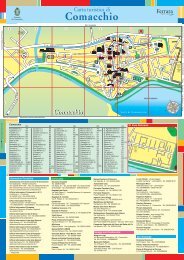Abstracts - Archeologia Medievale Venezia
Abstracts - Archeologia Medievale Venezia
Abstracts - Archeologia Medievale Venezia
You also want an ePaper? Increase the reach of your titles
YUMPU automatically turns print PDFs into web optimized ePapers that Google loves.
Rescue excavations carried out by the Greek Archaeological Service on various sites in the modern city of Sparta, as<br />
well as excavations conducted by the British School at Athens on the Spartan Acropolis, revealed remains of the<br />
Byzantine era and produced a rich variety of Byzantine ceramics dating from the 10th to the 14th centuries. These<br />
ceramic finds show a diversity of sources, which illustrate the commercial links with production centres within the Empire<br />
and with Italy or the Eastern Mediterranean area, and given the fact that it was found in the urban context of Sparta<br />
clearly indicates the prosperity of the town during the Byzantine period. Only a small portion of this material has been<br />
presented in preliminary reports with references to the context and the stratigraphical data.<br />
Recent excavations carried out by the 5th Ephorate of Byzantine Antiquities produced a great volume of stratigraphically<br />
examined ceramic finds. The vast majority of this material is unglazed, consisted of decorated and undecorated plain<br />
ware and cooking ware. Glazed ware constitutes a small proportion of the overall pottery. It includes a wide variety of<br />
shapes and decorative styles, such as sgraffito ware, green and brown painted ware, incised ware, plain glazed ware,<br />
slip painted ware, champlevé ware, aegean ware, measles ware, the so-called “protogeometric” small jugs. The imported<br />
ceramics include Constantinopolitan White ware, Zeuxippus ware, Zeuxippus Derivative Bowls, Protomaiolica bowls.<br />
Both plain and glazed ware provide important data on stylistic trends, technology of manufacture and distribution.<br />
The glazed pottery found in Sparta has prompted questions concerning the provenance and the chronology of the<br />
vessels. Sparta was hither to not been considered as a production center of any importance mainly because of its vicinity<br />
to Corinth, which was the leading center for commercial and artisanal activity in the Peloponnese during the Byzantine<br />
period. But the numerous Byzantine ceramics found in excavations, together with indications for local manufacture –<br />
tripods stilts and unfinished vessels discarded during production – have led to the suggestion that a number of ceramic<br />
objects are indigenous.<br />
This paper intends to stress the information to be gained by a study of the glazed wares, which come from stratified<br />
contexts of several plots recently excavated. A preliminary classification is provided following the criteria elaborated by<br />
scholars, in contrast with other assemblages, focusing in the yielded important data on questions of chronology and<br />
distribution and in the attempt to identify the characteristics (shapes, type of clay, decoration techniques) of locally<br />
produced wares.<br />
BOEHLENDORF B.: The byzantine pottery from Troad/Turkey<br />
The Troad, lying in the western part of Turkey, has been a region of great strategical importance up to the modern times<br />
and for this reason it was also eminent in the Byzantine period. The Troad had the control over the Hellespont, the<br />
passage from the Aegean See to Constantinople and the Black Sea, and features the strait of Çanakkale which provides<br />
the fastest crossing of the Dardanelles at their narrowest point.<br />
The Byzantine pottery discussed in this paper was found on different sites in the Troad: the finds come from the new<br />
excavations in Assos, and also from excavations in Chryse (Gülpinar), Troy and Beşiktepe. Two different surveys in the<br />
northern and southern part of the Troad give an area-wide spread of the Byzantine wares in this region. Due to the<br />
geographical position of the Troad, with even small villages in the hinterland having relatively easy access to major trade<br />
routes via the coast, middle and late Byzantine pottery from Constantinople, Greece, and other Anatolian cities such as<br />
Pergamon was found. One of these examples is the Glazed White Ware IV, which was found in many places in the<br />
Troad. The frequency shows an as yet unknown distribution of this ware and provides an informative basis for the<br />
discussion of imports and dates of this ware.<br />
Another characteristic feature of the Troad pottery from is the local Sgraffito- and Painted Sgraffito Ware in the style of<br />
the 13th century Zeuxippos Family. Due to the fabric, shapes and decorations this ware shows an independent<br />
interpretation of 13th century pottery fashion. Like the famous Zeuxippos ware the Troad sgraffito ware was also<br />
exported into Thrace and the western coast of Anatolia.<br />
The paper contains two parts: the presentation of the local pottery from the Troad with their typology and dates and the<br />
presentation of the ceramic imports. The second part deals with the distribution of these wares in Turkey.<br />
VROOM J.: Consuming History: early medieval pottery finds from recent excavations at Butrint, Albania<br />
Recent excavations by a British-Albanian team in the lower town of Butrint produced spectacular pottery finds of the<br />
Early Medieval period. Life in a tower, measuring 4.60 m by 4.40 m, was cataclysmically terminated when a fire brought<br />
the tiled first floor down upon the ground floor. Smashed beneath the debris of the burnt rafters and the roof tiles, a large<br />
collection of glass and an intriguing range of ceramics were retrieved.<br />
The pottery was the first assemblage in Albania to have ever been found in ‘Pompeian conditions’ to date. The ceramics<br />
consist, among others, of imported amphorae, painted vessels, locally made wares (so-called ‘Avaro-Slavic’ types), as<br />
well as two chafing dishes with glazed interiors. At the moment the pottery finds are tentatively dated to the 8th-early 9th<br />
centuries, while conclusive radiocarbon dating results are expected soon.<br />
Furthermore, recent excavations south of Butrint, in its Roman-period suburb on the Vrina Plain, brought to light another<br />
important Early Medieval find. It concerns the remains of an Early Medieval manorial residence, made in the ruins of a<br />
5th-century ecclesiastical community. Its ground floor was covered in a thick deposit of black earth, in which 41 bronze<br />
folles (spanning the period of circa AD 840-950) were found, as well as four government lead seals and large amounts of<br />
ceramics belonging to the same period. Furthermore, an Early Medieval pottery kiln was recovered next to the manor<br />
house.<br />
During the interpretation of both pottery assemblages from these recent excavations, attention will be paid to the<br />
importance of exchange, trade and consumption in the making of the Middle Ages in this part of the Mediterranean, as<br />
well as to their impact on the ongoing discussion on ‘Dark Age’ pottery.<br />
VEZZOLI V.: Le produzioni ceramiche della Siria settentrionale tra XI e XIV secolo: nuovi dati da Shayzar e<br />
Apamea<br />
Grazie a recenti indagini archeologiche si sta delineando un quadro sempre più dettagliato delle produzioni ceramiche<br />
della Siria del Nord tra XI e XIV secolo.<br />
7





